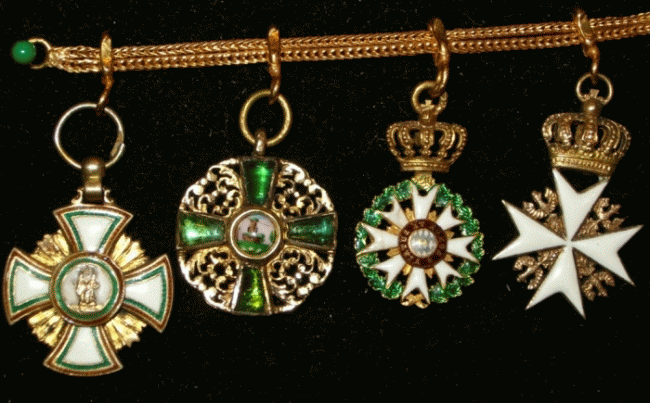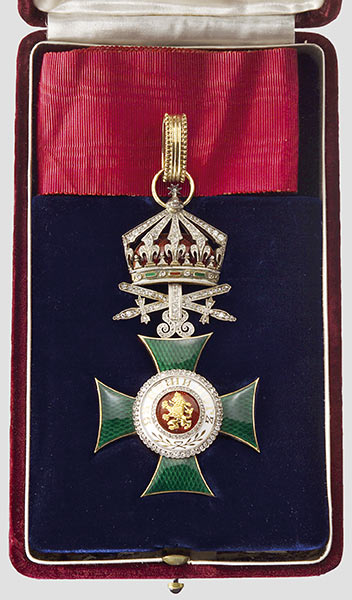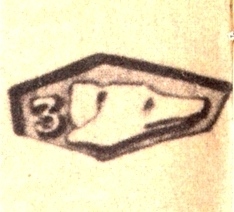-
Posts
1,712 -
Joined
-
Last visited
-
Days Won
3
Content Type
Profiles
Forums
Blogs
Gallery
Events
Store
Posts posted by Carol I
-
-
Nice family member

If I'm not mistaken, the first one is the Bulgarian Order of St. Cyril and Methodius.
Take a look at its larger cousin here at eMedals:
/Mike
Thanks for the reply. It could be an Order of St. Cyril and Methodius, but I do not think it is the Bulgarian one as the latter had quite different insignia. Here is a Grand Cross of the latter from the Bulgarian military museum.
 0
0 -
Thanks for sharing!

You're welcome.
 0
0 -
I have found some information on the net regarding the new Bulgarian orders.
By the Act on the Orders and Medals of the Republic of Bulgaria, adopted by the XXXIX National Assembly on May 29, 2003, Decree No.230 from June 9, 2003, promulgated in the State Gazette, issue 54 from June 13, 2003, and the Act on Amendment and Supplementing the Act on the Orders and Medals of the Republic of Bulgaria, adopted by the XXXIX National Assembly on May 20, 2004, Decree No.184 from May 20, 2004, promulgated in the State Gazette, extraordinary issue 43 from May 21, 2004, modern effective orders were instituted and their statute was established. Listed by their seniority, these orders are:1. The Order of Stara Planina;
2. The Order of St. St. Cyril and Methodius;
3. The Order for Civil Merit, the Order for Military Merit, the Order of the Madara Horseman.
The Order for Bravery - not included in the seniority ranking.
The Medal for Merit
0 -
My smallest family member. Judging from the company it's been keeping, It's either a commander or a 1st cl.

What is the first order, the one with white arms bordered with red and green?
0 -
To add just one thing, the numbers above refer only to the awards with the "princely crown" (not the "royal crown" that appears in all the images posted this far on this thread).
0 -
Up until 1908 there were 11 awards of the Bulgarian Order of St. Alexander 2nd class with surmounting swords. During the same period there were only 4 similar awards for the 1st class and 12 for the 3rd class. Who knows how many were awarded after 1908?
0 -
Here is an image from an old auction from La Galerie Numismatique with a certificate for the fourragere of the Star of Romania paired with a red fourragere with blue stripes.
 0
0 -
On some photos Lt. Col. Chiritescu with blue "furajera".
Igor, can you please give some details about the fourragere in your collection? What are its colours, dark blue and ...?
The image below is from an old auction from La Galerie Numismatique where a certificate for the fourragere of the Star of Romania is paired with a red fourragere with blue stripes. This appears to be in contradiction with the book by Safta et al where the same fourragere is described as blue with red stripes.
 0
0 -
Here is an image of a class II set of the Bulgarian Order of St. Alexander from the recent UBS auction.
 0
0 -
i found this one in my files and i found some info and pictures on Yuri Yashnev?s website:
http://www.netdialogue.com/yy/Europe/Bulga...StAlexander.htm
Hope, this helps...

Hi Gerd!
I think you have posted a badge third class (with diamonds) of the Bulgarian Order of St. Alexander. The badge second class had a white cross.
But this might be the star Rene is after:
0 -
Images of the Romanian Order for Industrial and Commercial Merit have been posted on the site of the Office of the President from an award ceremony (click on the photo below for more images from the event).
0 -
A thought as far as the mismatch goes:
I do not know what normal Rumanian practice was, but most European Orders had to be returned on the recipient's death. While any jeweller made piece might well have been purchased by the recipient, the insignia might also have been provided to the government on contract. Could it then be possible that a Hapsburg era contract piece was returned and sent out again to a new recipient when Resch was the Official Contractor? I know that in Germany iduring the First World War, orders from Saxony, Bavaria, and Baden dating back to the NAPOLEONIC wars were issued to officers just as if they had been newly made for bestowal. Since Resch would have had to supply new CASES to the Orders Chancery in Bucharest, then possibly they did the same thing
"recycling" turned in pieces.
Romanian orders did not have to be returned to the Chancellery of the Orders until King Carol II's reign and even then the rule was not strictly enforced. But if some orders were re-used, I do not think that Resch would allow the use of its cases with any other badge. On the other hand it was possible that other jewellers worked for the official contractors. I have seen one reference to Karl Fischmeister of Vienna who did that with Resch in the end of the 19th century. Then in WWII Zimmermann of Pforzheim worked for the National Mint.
Unfortunately, there is much uncertainty around such details as there is no serious study of the matter. I was kind of hoping that someone knew whether "AF" was a subcontractor or a major order jeweller and could thus tell if the set is genuine or a mismatch (accidental, due to greed etc.).
0 -
Thanks Rick for the scan. The marks look indeed like #60 and #111.
Actually, you are quite lucky the marks are as clear as they are here-- or you have talents as a photographer/scanner beyond my wildest dreams of emulation. I have a Vienna made Ottoman Osmanie Order 4th Class with marks 60 (but in a circle as is most often found circa WW1), 66a and 110 but since the Order is permanently sewn into its trifold I can't get AT them to scan flat.The scanner did not work, so I turned to the photo camera. I first tried to take photos in macro mode, but the images still did not turn out quite clear. At last I got the idea to use a 10x magnifier placed in front of the camera lens and I took several photos until I got the few I posted. The system is quite cumbersome with one hand holding the magnifier, the other one the camera and both of them trying to get the marks in focus and therefore the rate of success was rather low.
 0
0 -
Thanks Rick for the reply and the details.
Somewhere on there should be the "FR" stamp that does NOT as commonly misinterpreted mean the Rothe Company, but indicates luxury tax paid.No "FR" stamp.
 "AF" was the unidentified maker.
"AF" was the unidentified maker.There was a series of articles on the Serbian White Eagle Order made by "AF" with these marks, in 1979 in the journal of the Orders and Medals Society of America. I will scan the hallmarks page and post it here.
Thanks! I am looking forward to seeing the scans.
0 -
Looking for the marks of Prague, I stumbled upon an Italian page with the Austrian marks for silver. It seems that up to 1867 the town mark for Prague was "B" and then it was changed to "C". I presume the mark was changed again in 1922 with the introduction of the Czech marks when it became a "P".
TOWN IDENTIFICATION LETTER UP TO 1867:A=Vienna - B=Prague - C= Salzburg - D=Lwow - E=Cracovia (1807-1809) - E=Hall (1824-1866) - F=Brno - G=Lienz - H= Graz - I = Klagenfurt - K = Lubiana - L = Trieste
TOWN IDENTIFICATION LETTER FROM 1867:A=Vienna - B=Lienz - C=Prague - D=Brno -E=Cracovia - F=Lwow - G=Graz - H-Hall - H=Bregenz (from 1872)- K=Klagenfurt - L=Lubiana - M=Trieste - N=Zadar - P=Pest - R=Kosice - T=Timisoara - U=Alba Iulia - V=Zagreb
And one more thing from that page. Apparently the Austrians also used a dog head mark from 1867.

 1
1 -
Carol, in Google type in Order of the Crown of Romania and it should give you several websites. Choose marksmedals.com/romanian_medals (it has some other stuff after this) and you will have enough to keep you interested for a while.
I know Mark Piersall's site. It is one of the best on the two oldest Romanian orders (information and images). And I see now what you meant by 29 variations, but I do not regard the various grades of the order as variations.
If you find someting more on these marks, please let me know. This far I managed to find an image of the Czech marks on the Online Encyclopedia of Silver Marks. Too bad they do not have real images.
0 -
By process of elimination : Type 1 1881 - 1932, Rabbits head (hare, actually) 1922 - present. Had to be made between 1922 and 1932. If the box is dated earlier then either it is mismatched or it was in stock by the medal maker. They probably ordered say 100 boxes and stuck them on the shelf and used them as they produced individual medals.
Thanks again Dave. So it was a mismatched set after all.
 I believe there were 29 different versions of this one medal alone!
I believe there were 29 different versions of this one medal alone!Could you please give me more details about this? Were there 29 known manufacturers? Can you please share the information you have on this? Thanks.
0 -
Carol - Austrian hallmarks before 1886 were of 2 kinds, both had a cross on them, very clear. From 1886 - 1922 they had the head of the goddess Diana. From 1922 - present contains a toucan's head with numbers to the right,(4 = .750 silver) and city letter to the left (W = Wien, Vienna). The earlier hallmarks had A = Wien, Vienna. So if you can squint at the "rabbit's head" and maybe make it seem more like a toucan's head then it was probably made in Austria. Still can't find a maker though.
Thanks Dave for the details. If the case belongs to the badge, the order is from the period 1881-1914, so we narrowed down the period. However, no matter how hard I try, the mark does not look like a cross or a goddess' head. So it comes down to a Czech mark from a town denoted by "A" or at least something that looks like an "A" ... a tough nut to crack.
 0
0 -
I have just seen Rod's post below from Straighten Me Out:
I have been able to find out that the "A" denotes Vienna and that the place of manufacturer was required after 1876.Could this mean that the marks on the badge above are in fact Austrian and the badge was made in Vienna? Maybe the Czechs used the general markings of the Austro-Hungarian empire.
I took another look at the marks and the letter to the left of the rabbit's head appears to be an "A" as well (though I am still not 100% sure).
0 -
The marks appear to be: "VL" (maker's mark), Finnish crown stamp, "813H", boat stamp for Helsinki (place of assay) and "P.5" (for 1920).
0 -
Order for Military Merit, 5th class
with war decoration and the ribbon of the Military Order for Bravery
 0
0 -
Order for Military Merit, 5th class
 0
0 -
Order for Military Merit, 4th class

Does anyone have a spare a ribbon for this badge?
 0
0 -
Order for Civil Merit, 4th class
 0
0







Italy - Order of the Roman Eagle & ISR Awards
in Southern European & Balkan States
Posted
From the recent UBS auction
Grand Cross with swords